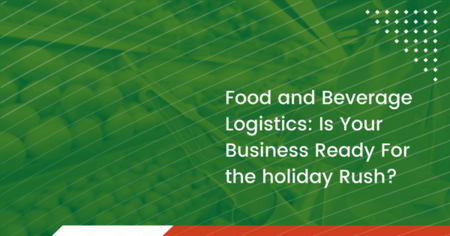How does food and beverage logistics work?
Food and beverage logistics is, like most supply chains, very complex. However, it begins simply enough as food moves from a farmer’s field to a manufacturer and then to a significant distribution point. At these major distribution hubs in the United States, shipping providers consolidate the food shipments. Then, they move it to the retailer’s or food service provider’s distribution center. Later, the product is off to the grocery store or restaurant.
How can your business prepare for food and beverage logistics?
To arrange food and beverage logistics properly, you need to work ahead. A few essential preparation steps will help you prevent major food and beverage logistics bottlenecks.
Secure shipping capacity
Securing the required capacity is vital for any logistics organization and even more for food and beverage logistics. Since many food products are perishable, shippers must take care of the cold supply chain in time. Sometimes, this task gets highly complicated due to the limited reefer capacity. Besides, the cold supply chain is not immune to today’s logistics gridlock. So, shipping companies must secure capacity leading up to the holiday season. In a supply chain that requires multiple hand-offs, carriers, shippers, and brokers must keep things moving forward during spikes to ensure that product makes it to stores and restaurants safely and freshly.
Improve stock management
The costliest consequence of not securing capacity is undoubtedly late shipments. With products arriving late and potentially not fresh, customer relationships along with the bottom line suffer. If consumers cannot find their needed goods, they will shop and spend their money elsewhere. PLS Logistics Services sees an increase in demand for our 3PL services during the high spike times. We work hard to meet customer needs, but businesses must plan accordingly.
Since retailers are highly promotional and consumer behavior can be generally erratic and impulsive (especially during the holidays), stores and restaurants need to be able to refill their inventory. To backfill as quickly as possible, distribution centers along the supply chain utilize food held within the centers. They will hold up 30 days of inventory for products like frozen meat to fill the demand. For produce, centers will have stock for only 48 hours because of the shorter shelf life.
Avoid products spoilage
All the planning in the world will not help if your product arrives unusable. Shippers and retailers alike expect food to arrive on time and fresh, thus heightening the importance of on-time delivery and carrier reliability. Refrigerated trucks must also meet meticulous regulations and come with added fuel consumption costs because of the energy needed to maintain the correct climate.
On top of the added fuel costs, have you planned for additional temperature checks? Trucks carrying frozen or temperature-sensitive items require temperature checks to maintain food integrity. These checks occur before the product is placed in the truck and at multiple points along the journey. Even products like soda, which do not need to be shipped at a specific temperature, must be climate controlled enough so that extreme heat does not damage the shipment.
Before launching your food and beverage shipments, confirming compliance with the FDA Food Safety Modernization Act (FMSA) is vital. It will legally ensure that the products are safe for consumers and are allowed for transportation in suitable conditions.
Packaging for food and beverage logistics
Proper packaging significantly contributes to your food products’ freshness and safety. If packaged correctly, your items can maintain the required temperature in case of shipping disruptions and technical outages. You may apply various coolants to prevent spoilage of frozen foods and use additional wrapping materials to avoid leaks.
Since beverages often come in glass bottles, you need to consider reliable packaging for fragile objects. Fortunately, today you can find numerous options for void fillers that prevent transportation effects and ensure products’ integrity.
Plan the drop-off
An important part of food and beverage logistics is the drop-off. Retailers and restaurants almost always require shipments to be dropped off during specific delivery windows because of limited staffing resources, so they need the delivery to arrive when they have adequate staff.
To avoid possible drop-off challenges, you need to stay in touch with the receivers and follow the agreed delivery schedule. Often, logistics processes can evolve external factors and unpredictable situations, causing schedule shifts and shipping delays. In such cases, you can keep your partners updated via transportation management systems (TMS) that reflect your shipments’ location and predict possible setbacks.
Food and beverage logistics with 3PL
Companies do their best to anticipate demand spikes and ensure they have enough secured capacity to move their product. However, the cluttered supply chain makes this more challenging than in years past. Do not let the holidays sneak up on your business. Contact PLS Logistics Services and utilize our vetted carrier network of 55,000 to confirm your capacity and organize a seamless food and beverage delivery.


